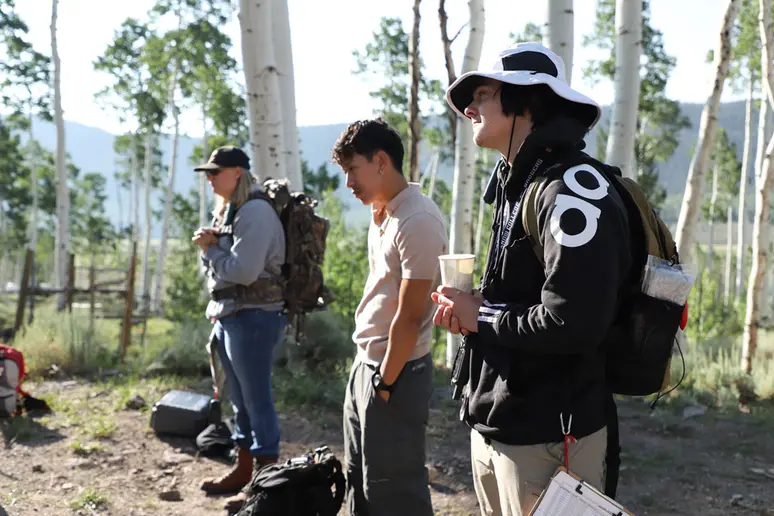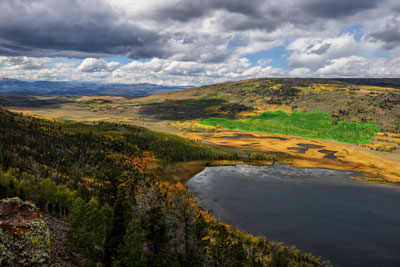

Wilson Thorpe (right) and Ngawang Salaka (center) take part in morning Q&A talk with fellow participant Kaylee Carlson for the Pando Photographic Survey (Tonia Lewis/Friends of Pando).


Wilson Thorpe (right) and Ngawang Salaka (center) take part in morning Q&A talk with fellow participant Kaylee Carlson for the Pando Photographic Survey (Tonia Lewis/Friends of Pando).
Visual Arts and New Media students Ngawang Salaka and Wilson Thorpe had a once-in-a-lifetime experience last summer as part of a team drawn to the Utah heartland to create the first complete photographic survey of the world’s largest living organism.
Their subject, the Pando tree, is comprised of over 40,000 trunks, or branches, and connected by a massive root system that spans 106 rugged acres in Fishlake National Forest. Its branches appear to be unique tree trunks, but they are actually genetically identical parts of the same tree connected by a network of roots scientists estimate could span 12,000 miles if laid end to end, or halfway around the world.
The Pando Photograph Survey team of 15 students and citizen scientists spent one week in early August, when the tree’s vitality was on full display, to capture images. Using cutting-edge 360-degree cameras, team members were trained by Lance Oditt, the Pando Photographic Survey director and lead photographer, and Ryan Thalman, associate professor of chemistry and natural resources at Snow College, and took aim to capture some 8,600 pre-defined locations to record the tree’s expanse.
The record they created will be compiled to provide the first comprehensive color photo of the tree for study and the largest picture of a tree ever attempted.
Fredonia’s students were connected to the Pando project by Graphic Design Associate Professor Jason Dilworth, who brought Mr. Oditt to campus to present a Pando workshop at a Fredonia Earth Day observance.
“After that, it didn’t take much thought to realize what an opportunity it would be to come out there,” Mr. Salaka, a senior, remembers. “Why not jump on the opportunity to contribute to something that is bigger than yourself, both figuratively and physically.”

In addition to helping to document 74 acres of the 106-acre tree over seven days, the Fredonia students participated in evening education workshops about the tree and its environment, social hours with peers from across the U.S., interviews, as well as intensive brainstorm and dialogue sessions with production team leaders and mentors in design and mass media.
The finished project will have a two-fold purpose. It will result in a scientific document featuring location data and images of the tree that scientists can use to study the tree, as if they were there, on desktop, mobile or virtual reality headsets. It will also produce a land-scale virtual interactive installation where Pando’s land mass will be overlaid on to other locations and people will be invited to walk its expanse and learn about the tree as they do on their mobile devices, making the rugged land it calls home accessible to everyone.
Oditt indicated the Pando photographic record will be released next spring, followed by “Pando: The World Tree,” a virtual land art installation, in the fall of 2022 or early 2023.
Still images taken by the students are a vital record which scientists can use to study the tree and monitor its health for generations to come. That is critical, as there is evidence that Pando is in decline and there is still much to be learned about the tree. Scientists estimate the tree has been alive for between 8,000 and 12,000 years.
Salaka said the Pando tree “breaks all definitions of what we think a tree is as humans.”
“When you first step into Pando, you see a forest of aspen trees, however the thing about this forest is that it is not really a forest at all. The definition of a forest requires multiple trees; Pando is just one tree that has over 40,000 stems that resemble what we think of as trees,” Salaka said.
Being able to contribute to a brand-new historical record with other members of the photographic team was more than extraordinary, Salaka said. “A life changing experience to say the least.”
Dilworth believes a key takeaway from this experience for design students who work mostly in digital space is learning about exploratory research that has the potential to change career trajectories. “It’s getting outside of the classroom, learning from landscapes and forest scapes,” Dilworth said. “This shows the importance of ecological work,” he added.
Fully immersed in the project, the students learned from photographers, designers, forest researchers, wildlife biologists and other professionals and gained an appreciation of the collaboration process that makes such an ambitious project possible to pursue.
“They have the experience of being at 8,000 feet, seeing one of the earth’s most incredible living organisms,” Mr. Dilworth said.
The photographic team included over a dozen college students enrolled in natural sciences, art, film and design programs from across the United States.
Salaka found the significance of collaborating with others who came from different walks of life and carried different perspectives was a major takeaway of the Pando experience. “Being able to come together and tackle issues together as one seems to be crucial to solving problems that fill our world today,” he said.